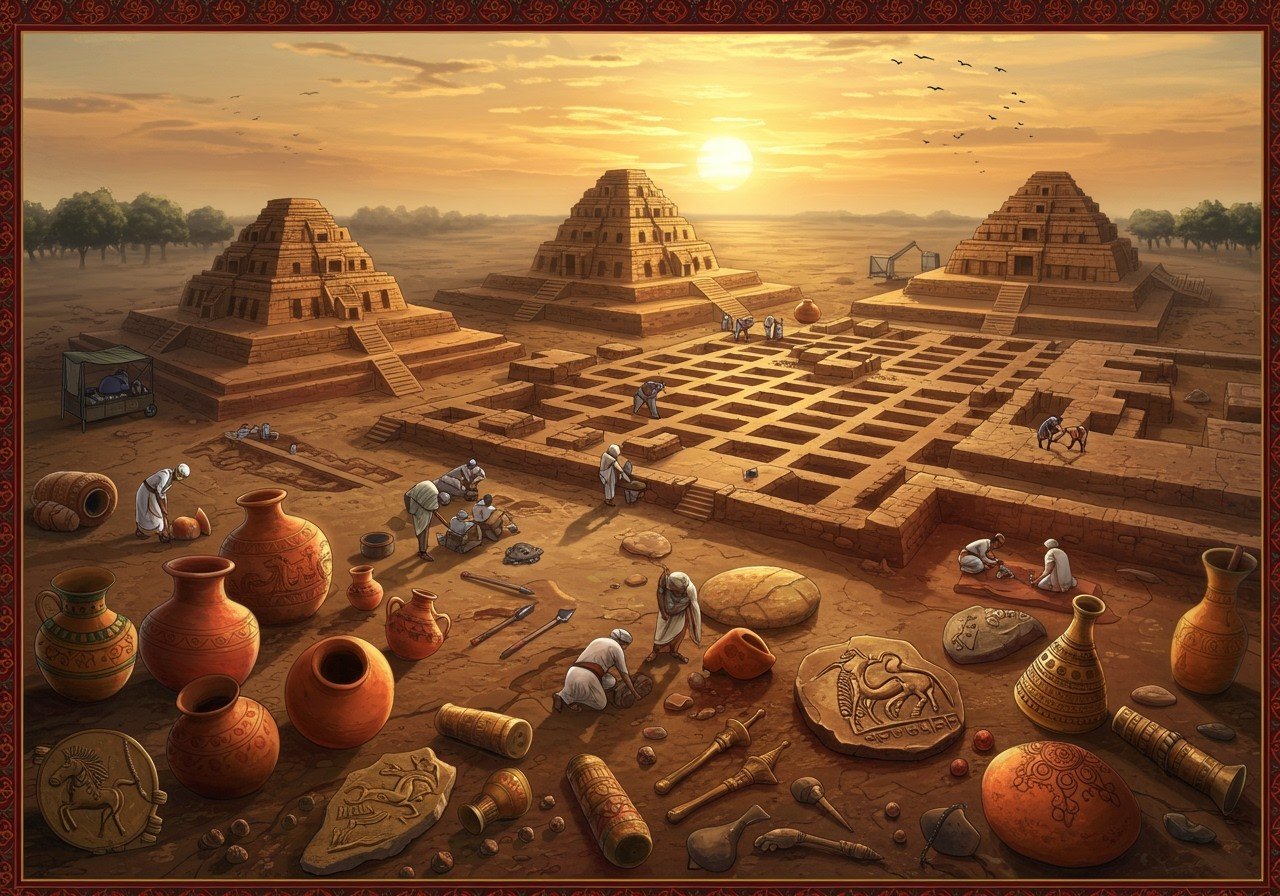
Rakhigarhi, the largest Harappan site in the Indian subcontinent, holds immense significance for UPSC aspirants. Located in Hisar district, Haryana, this archaeological marvel dates back to around 6500 BCE, placing it among the oldest cities of the Indus Valley Civilization. Recognized as a ‘site of national importance’ by the Archaeological Survey of India (ASI), Rakhigarhi stands as a testament to India’s rich cultural heritage. This blog delves into the key aspects of Rakhigarhi, providing valuable insights for UPSC exam preparation.
Location and Discovery
Rakhigarhi is situated in Hisar district, Haryana. Initially discovered in the early 1960s, the site’s vast expanse of over 350 hectares surpasses even the renowned Mohenjo-daro in size. Excavations have revealed remarkable evidence of advanced urban planning, including well-structured streets, intricate drainage systems, and sophisticated multi-roomed houses. These findings offer a glimpse into the ingenuity and organizational prowess of the Harappan civilization.
Historical Significance
Rakhigarhi flourished as a major urban center during the Harappan period, approximately between 2600-1900 BCE. The site’s archaeological remains showcase a highly structured society with remarkable architectural skills. Unearthed artifacts such as seals, pottery, and other remnants indicate robust trade connections with contemporary civilizations. Rakhigarhi’s significance lies in its ability to illuminate the socio-economic, cultural, and religious practices of the Harappan people, including their burial customs and lifestyle.
Key Archaeological Findings
Rakhigarhi’s excavations have yielded a wealth of archaeological treasures, including:
- Multi-roomed houses with courtyards, showcasing sophisticated residential architecture. These structures indicate a well-developed sense of domestic space and community living. The presence of courtyards suggests a focus on open-air living and social interaction within the household.
- Intricate drainage systems, demonstrating advanced sanitation practices and urban planning. These systems highlight the Harappans’ understanding of hygiene and their ability to engineer complex infrastructure for water management.
- Well-planned streets, reflecting organized urban development and efficient traffic management. The layout of the streets suggests a deliberate design to facilitate movement and accessibility within the city.
Further discoveries include pottery, jewelry crafted from semi-precious stones, and seals bearing inscriptions, all indicative of a sophisticated trade network. Skeletal remains unearthed at the site have provided invaluable insights into the health, diet, and genetic composition of the Harappan people. The presence of a granary suggests advanced agricultural practices and organized food storage, revealing the civilization’s ability to sustain a large urban population.
DNA Analysis and Genetic Studies
Groundbreaking DNA analysis conducted on skeletal remains from Rakhigarhi has revolutionized our understanding of the Harappan people’s genetic heritage. The research suggests a remarkable genetic continuity between the Harappans and the present-day population of the region, challenging earlier theories of large-scale migrations. These findings support the notion that the Harappan civilization was indigenous to the Indian subcontinent, providing crucial insights into the demographic history of the region.
Cultural and Societal Insights
The artifacts and architectural features of Rakhigarhi offer a captivating glimpse into the daily lives of the Harappan people. Standardized weights and measures indicate a regulated economic system, while the diverse pottery styles suggest a rich cultural exchange and artistic expression. Intricately crafted jewelry and tools point to specialized professions and advanced craftsmanship. The layout of houses and public spaces reflects a well-organized society with defined social hierarchies and a strong sense of community.
Rakhigarhi in the UPSC Syllabus
For UPSC aspirants, a thorough understanding of Rakhigarhi is essential for navigating topics related to ancient Indian history and archaeology, particularly the Indus Valley Civilization. Key areas to focus on include:
- Urban planning and architecture: Analyze the sophisticated city layout, drainage systems, and residential structures to understand the advanced urban development of the Harappan civilization. This knowledge is crucial for understanding the complexities of ancient urban societies.
- Trade relations: Examine the artifacts and evidence of trade networks to understand Rakhigarhi’s connections with other contemporary civilizations. This aspect highlights the economic and cultural interactions of the Harappan people.
- Socio-cultural aspects: Explore the artifacts, burial practices, and daily life evidence to gain insights into the social structures, cultural practices, and beliefs of the Harappan people. This understanding is crucial for a holistic view of the civilization.
- Recent findings, including DNA studies: Stay updated on the latest research, including DNA analysis, which offers new perspectives on ancient migrations and population continuity. These findings often challenge existing theories and provide a deeper understanding of the Harappan civilization.
Exploring related topics such as Hinduism’s Global Reach, Hinduism’s History and Origin, and Ramayana’s Life Lessons can enrich your understanding of ancient Indian culture and history. For those interested in delving deeper into religious practices, resources on Dharma in the Ramayana are also available.
Poojn.in: Your Resource for Cultural Exploration
For a tangible connection to ancient Indian culture, explore the authentic ritual items available at poojn.in. Discover a range of products, including Tulsi Malas and Rakhis, to enhance your understanding of traditional crafts and rituals. These items can serve as valuable study aids and provide a deeper appreciation for India’s rich cultural heritage.
Conclusion
Rakhigarhi stands as a treasure trove of knowledge about the Indus Valley Civilization. Its sophisticated urban planning, intricate artifacts, and groundbreaking DNA studies provide invaluable insights into ancient Indian history and culture. For UPSC aspirants, Rakhigarhi is a crucial topic that connects the past with the present. By understanding this remarkable site, you gain a deeper appreciation for India’s rich heritage and strengthen your foundation for exam success. Embrace the wisdom of Rakhigarhi, and let it inspire your journey towards excellence.


